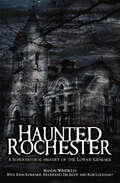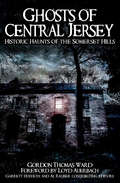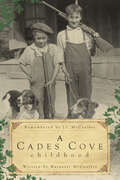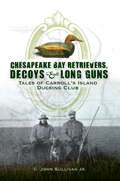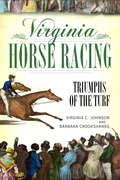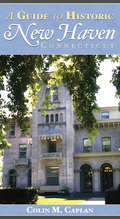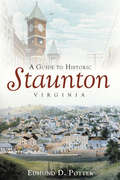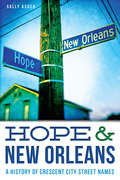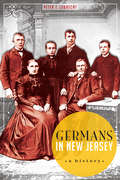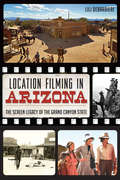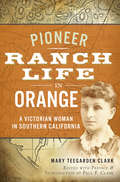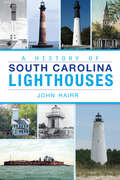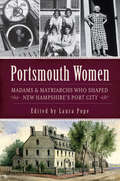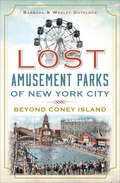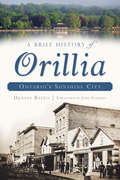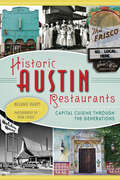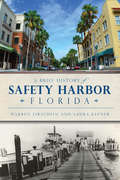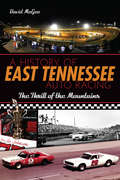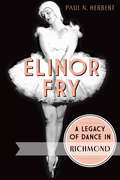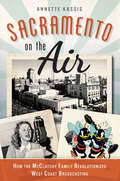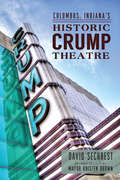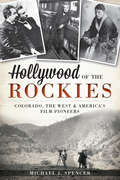- Table View
- List View
Haunted Rochester: A Supernatural History of the Lower Genesee (Haunted America Ser.)
by Mason Winfield John Koerner Reverend Tim Shaw Rob LockhartThe western New York state Great Lakes region serves as a scenic setting for supernatural traditions, incidences, and folklore. Avenging specters, demon-tortured roads, holy miracles, weird psychic events, prehistoric power sites, ancient curses, Native American shamans, active battlefields, ghost ships, black dogs, haunted monuments, and the phantoms of Rochester&’s famous—all are part of the legacy of Rochester and the lower Genesee. Supernatural historian Mason Winfield and the research team from Haunted History Ghost Walks, Inc., take us on a spiritual safari through the Seneca homeland of the &“Sweet River Valley&” and the modern city in its place. After their survey of Rochester&’s super natural history and tradition, &“the Flour City&” will never look the same. Includes photos!
Ghosts of Central Jersey: Historic Haunts of the Somerset Hills (Haunted America Ser.)
by Gordon Thomas WardTour historic sites and buildings in New Jersey—and learn about the spirits that are said to haunt them. Includes photos! Ranging from the shadowed woods of the Somerset Hills to the dappled banks of the Delaware River, Ghosts of Central Jersey delivers a rich mix of factual history and the sound investigation of ghostly phenomena. This collection of reports on local legends and traditional stories informs, entertains, and takes you to places in New Jersey where the past is considered to be very much alive and entwined with the present.
A Cades Cove Childhood (American Heritage)
by J. C. Mccaulley Margaret MccaulleyThe remote Smoky Mountain community of Cades Cove still lives in the memory of J.C. McCaulley, one of the few remaining former residents, who offers an exclusive glimpse into a childhood in the Cove. His stories, compiled by his wife Margaret, are a testament to a way of life long abandoned--a life before automobiles, television and perhaps too much exposure to the outside world; a life of hard work and caring for your neighbors. Join the McCaulleys in their quest to preserve the beauty, tranquility and traditions of this pristine community, and dare to dream of a way of life that encouraged independence, integrity and the courage to overcome adversity.
Chesapeake Bay Retrievers, Decoys & Long Guns: Tales of Carroll's Island Ducking Club
by C. John Sullivan Jr.Carroll�s Island is one of many places along the ChesapeakeBay where vibrant stories of dogs, decoys, guns and waterfowl resonate up from the shoreline. The stories from Carroll�s Island Ducking Club, which was founded in the mid-nineteenth century, offer special insights about the Chesapeake Bay�s waterfowling heritage. In this warm, informative book, C. John Sullivan Jr., one of the nation�sleading decoy collectors and scholars, documents the development of the Chesapeake Bay retriever and how gunners once devised decoys and new firearms and enjoyed the bounty of the Chesapeake Bay. Eventually Carroll�s Island Ducking Club would disappear, but its legacy can still be seen today in the role members played in establishing the Chesapeake Bay retriever as Maryland�s state dog.
Virginia Horse Racing: Triumphs of the Turf (Sports)
by Virginia C. Johnson Barbara CrookshanksVirginia, mother of presidents, is also the mother of American horse racing. From the very beginning, Virginians have risked it all on the track as eagerly as on the battlefield. Follow the bloodlines of three foundation sires of the American Thoroughbred through generations of rollicking races and larger-than-life grandees wagering kingly stakes, sometimes on horses not yet born. How did the horse nicknamed Damn His Eyes get protection money from other horse owners? What did it mean to �tap the claret� to break a neck-and-neck tie? Why was Confederate cavalry so much better than Union�was it the riders, or was it the mounts? All these and many more stories of horsemanship on and off the track fill the pages of Virginia Horse Racing: Triumphs of the Turf.
A Guide to Historic New Haven, Connecticut (History & Guide)
by Colin M. CaplanAuthor Colin M. Caplan is a native of New Haven and an active member of the local architecture and preservation community. He founded Magrisso Forte, a design-based consulting firm dedicated to fostering awareness of New Haven's cultural resources. This book details eighteen walks and nine guided driving/biking tours around the city.
A Guide to Historic Staunton, Virginia (History & Guide)
by Edmund D. PotterUnlike many small towns in the South that were occupied by the Union army, beautiful Staunton, Virginia, emerged from the Civil War largely unscathed. Join historianEdmund Potter on a walking tour through the many architectural gems and notable buildings of downtownStaunton's five National Historic Districts. From thepicturesque Wharf Area to the birthplace of Woodrow Wilson to the town's many historically African American businesses, A Guide to Historic Staunton offers visitors and residents alike a deeper appreciation of their remarkable surroundings.
Hope & New Orleans: A History of Crescent City Street Names (Landmarks)
by Sally AsherNew Orleans is a city of beautiful contradictions, evidenced by its street names. New Orleans crosses with Hope, Pleasure and Duels. Religious couples with Nuns, Market and Race. Music, Arts and Painters are parallel. New Orleans enfolds its denizens in the protection of saints, the artistry of Muses and the bravery of military leaders. The city's street names are inseparable from its diverse history. They serve as guideposts as well as a narrative that braid its pride, wit and seedier history into a complex web that to this day simultaneously joins and shows the cracks within the city. Learn about Bourbon's royal lineage, the magnitude of Napoleon's influence, how Tchoupitoulas's history is just as long and vexing as its spelling and why mispronouncing such streets as Burgundy, Calliope and Socrates doesn't mean you are incorrect--it just means you are local Told with precision and photos as vibrant, irreverent and memorable as La Nouvelle Orleans itself, author Sally Asher delivers an updated and reinvented look at the city that care forgot.
Germans in New Jersey: A History (American Heritage)
by Peter T. LubrechtGerman immigrants and their descendants are integral to New Jersey's history. When the state was young, they founded villages that are now well-established communities, such as Long Valley. Many German immigrants were lured by the freedom and opportunity in the Garden State, especially in the nineteenth century, as they escaped oppression and revolution. German heroes have played a patriotic part in the state's growth and include scholars, artists, war heroes and industrialists, such as John Roebling, the builder of the Brooklyn Bridge, and Thomas Nast, the father of the American cartoon. Despite these contributions, life in America was not always easy; they faced discrimination, especially during the world wars. But in the postwar era, refugees and German Americans alike--through their Deutsche clubs, festivals, societies and language schools--are a huge part of New Jersey's rich cultural tapestry.
Location Filming in Arizona: The Screen Legacy of the Grand Canyon State
by Lili DebarbieriThe scenic natural vistas of Arizona's deserts and mountains have made it a favorite backdrop of movies and television shows. Westerns such as silent-era pictures derived from Zane Grey fiction through the John Ford-John Wayne classics "Stagecoach "and "The Searchers "benefited from the beautiful and rugged landscapes. TV classics such as "Gunsmoke" and "Little House on the Prairie" helped define Arizona's allure for Hollywood. Oscar winners "Jerry Maguire" and "Little Miss Sunshine "took advantage of the infrastructure that accumulated to lure filmmakers to Tucson, Yuma, Phoenix, Prescott, Sedona and all corners of the Grand Canyon State". Join author Lili DeBarbieri as she looks at the movies and shows shot in the state, as well as other aspects of Arizona film culture.
Pioneer Ranch Life in Orange: A Victorian Woman in Southern California
by Paul F. Clark Mary Teegarden ClarkThis previously unpublished account of early California ranch life from 1875 to 1887 covers a pivotal era in Orange County history. Vassar-educated Mary Teegarden Clark captured the future Orange County during its transition from the untamed cattle rancho era to citrus empire. Mary writes engagingly about breaking ground for the citrus Yale Grove in the city of Orange, her home life with husband Albert B. Clark and workaday ranch chores with Chinese and Latino farmhands. Her firsthand accounts enlarge the historical record of citrus marketing, wilderness excursions and the escapades of Wild West pistoleros. Through deft editing, Paul F. Clark, Mary's great-grandson, provides the historical framework through which to view Mary's remarkably vivid experiences.
A History of South Carolina Lighthouses (Landmarks)
by John HairrBefore radar, depth finders and satellite-guided navigation, long before the seafloor was charted with scientific precision, mariners relied on lighthouses to approach a coastline safely. South Carolina's history with lighthouses goes back nearly two and a half centuries. At Cape Romain, a windmill was converted into a lighthouse. St. Philip's Church in Charleston was converted into a beacon for seafarers to aid navigation to the Holy City. With such a long and storied past, the story of South Carolina's lighthouses is inseparable from its maritime history. Join author John Hairr as he recounts the fascinating history of these beacons that have shone above the shores of the Palmetto State.
Portsmouth Women: Madams & Matriarchs Who Shaped New Hampshire's Port City (American Heritage)
by Laura PopeIn the history of Portsmouth, New Hampshire, countless women rose above a rigid society to make their marks on the seaport city. In the eighteenth century, Allice Shannon Hight became a successful tavern keeper, outliving two husbands and providing for ten children. Others flourished in more scandalous ventures, like Alta Roberts, otherwise known as the Black Mystery of Portsmouth--always donned in black, she operated a successful brothel at the Roberts House Saloon in the nineteenth century. Even greater achievements would come in later years from the likes of Mary Carey Dondero, who became one of the first women elected mayor in New England. This collection of essays, compiled by author and historian Laura Pope, celebrates the victories--large and small--of Portsmouth's notable women.
Lost Amusement Parks of New York City: Beyond Coney Island (Lost Ser.)
by Barbara Gottlock Wesley GottlockA historical tour of fun and frolic in the five boroughs—including photos from the good old days. Coney Island is an iconic symbol of turn-of-the-century New York—but many other amusement parks have thrilled the residents of the five boroughs. Strategically placed at the end of trolley lines, railways, public beaches, and waterways, these playgrounds for the rich and poor alike first appeared in 1767. From humble beginnings, they developed into huge sites like Fort George, Manhattan&’s massive amusement complex. Each park was influenced by the culture and eclectic tastes of its owners and patrons—from the wooden coasters at Staten Island&’s Midland Beach to beer gardens on Queens&’ North Beach and fireworks blasting from the Bronx&’s Starlight Park. As real estate became more valuable, these parks disappeared. With this historical tour, you can rediscover the thrills of the past from the lost amusement parks of New York City.
A Brief History of Orillia: Ontario's Sunshine City (Brief History)
by John Forrest Dennis RizzoLocal author Dennis Rizzo tells the fascinating and diverse history of Orillia, Ontario. First populated by the Huron, Iroquois and Chippewa Nations, Orillia is now a well-loved, year-round recreation destination. Its history is deeply tied to its water. Situated in the narrows where Lake Simcoe flows into Lake Couchiching, Orillia was a gathering place for centuries before Europeans used it to bring furs to market. Sir John Simcoe, first governor of Upper Canada, fostered permanent settlement of the area. A gateway to the Muskoka region, it has been home to lumber, manufacturing, and artistic endeavours. Today, summer cottagers and winter athletes alike enjoy the Sunshine City and its more than twenty annual festivals. Local author Dennis Rizzo tells the fascinating and diverse history of Orillia, Ontario.
Church Street: The Sugar Hill of Jackson, Mississippi (American Heritage)
by Benjamin Bradley Grace SweetThe 1930s and 1940s saw unprecedented prosperity for the African Americans of Jackson's Church Street. From the first black millionaire in the United States to defenders of civil rights, nearly all of Jackson's black professionals lived on Church Street. It was one of the most popular places to see and be seen, whether that meant spotting Louis Armstrong strolling out of the Crystal Palace Club or Martin Luther King Jr. organizing an NAACP meeting at his field office on nearby Farish Street. Join authors and veterans of Church Street Grace Sweet and Benjamin Bradley as they explore the astounding history and legacy of Church Street.
Historic Austin Restaurants: Capital Cuisine through the Generations (American Palate)
by Melanie HauptAustin has staked its claim as the seat of innovative culinary movements, and its food culture mirrors the transformations taking place across the city. The evolution of the east side is reflected in joints like Franklin Barbecue, while landmarks like Scholz Garten, the oldest restaurant in the capital, testify to the contributions of the town's college presence and a healthy German influence. Joe's Bakery isn't just one of the town's most beloved Tex-Mex spots; it's the place where the real wheeling and dealing in Texas politics happens. Food writer Melanie Haupt samples Austin's iconic restaurants and the rich heritage that produced them.
A Brief History of Safety Harbor, Florida
by Warren Firschein Laura KepnerAccording to legend, Spanish explorer Hernando de Soto arrived on the shores of Safety Harbor in 1539 believing that he had discovered the fabled Fountain of Youth. For centuries, the area's natural mineral springs had hosted the Tocobaga people and would later attract early pioneers to west-central Florida. The natural mineral springs drew visitors to bathe in their restorative waters, and in the twentieth century, they were eventually transformed into the world-famous Safety Harbor Resort and Spa, enjoyed by wealthy socialites and professional athletes for decades. Today, the city is best known for its abundance of festivals and the collection of artists, writers, poets and musicians who call it their home--an oasis of calm within bustling Pinellas County. Join authors Warren Firschein and Laura Kepner as they detail the vibrant history of scenic Safety Harbor.
A History of East Tennessee Auto Racing: The Thrill of the Mountains (Sports)
by David McgeeEast Tennessee isn't typically mentioned among stock car racing's formative hotbeds. But the region from Bristol to Oneida and Chattanooga encapsulates a significant portion of the sport's history. From pioneers like Brownie King and Paul Lewis of Johnson City to former national champions Joe Lee Johnson of Chattanooga and L.D. Ottinger of Newport, East Tennessee has produced many of NASCAR's great drivers. The region is home to one of the world's largest sports stadiums in the Bristol Motor Speedway, but NASCAR also made regular visits to other area tracks. Whether the surface is red clay, asphalt or brushed concrete, East Tennessee still boasts some of the world's fastest, most competitive racing. Join author and racing insider David McGee as he presents a vast array of colorful characters whose passion fueled a sport that has gone from primitive to prime time.
Elinor Fry: A Legacy of Dance in Richmond
by Paul N. HerbertIn Richmond, no other name is more synonymous with dance than Elinor Fry. Helen Keller, Bill "Bojangles" Robinson and author Tom Wolfe were just some of the people with whom Fry connected in five decades of dance. From 1920 to 1970, Fry was involved, often accompanied by her beloved students, in nearly every major public event in the River City. Performing in an array of venues and photographed twice by "National Geographic," Fry was a blend of creativity and business savvy and a wonderful role model for thousands of children who learned dance in her studio. Join author and historian Paul Herbert as he celebrates Elinor Fry's spirit and exceptional achievements in the world of dance in Richmond.
W.L. Dow: The Architect Who Shaped Sioux Falls
by Jennifer DumkeWallace L. Dow's enduring legacy is visible throughout Sioux Falls and across South Dakota. His distinctive structures, whether civic buildings or private residences, are beholden to no single architectural style. A New Hampshire native, Dow was brought to the Dakota Territory in the 1880s by Governor Nehemiah Ordway. Dow quickly established himself as the preeminent architect of the Dakota prairie, designing iconic structures like Sioux Falls Courthouse and the penitentiary, as well as many beautiful private residences. Using local Sioux quartzite, Dow's buildings gave the emerging Dakota Territory an identity. Yet the architect himself remains something of a mystery. Join author and Dow documentarian Jennifer Dumke as she uncovers Dow's story, recounting the life and work of a true Sioux Falls original who left his mark statewide.
Sacramento on the Air: How the McClatchy Family Revolutionized West Coast Broadcasting
by Annette KassisIn 1921, a chance encounter with a radio receiver sent Sacramento Bee newspaperman Carlos McClatchy on a determined path to break into broadcasting. Ushered by the enterprising McClatchy family, the Bee became the first Pacific Coast newspaper to enter the radio business. For decades, broadcasting in Sacramento was shaped by the brilliant but fatally flawed Carlos McClatchy; his strong-willed, micromanaging father, C.K.; and his sister Eleanor McClatchy, who sacrificed her own aspirations for the sake of the family business. From a single five-watt station, the family built a large media company, established a radio network with William Randolph Hearst and helped shape media in the American West. Historian Annette Kassis tells the fascinating story of the pivotal McClatchy family and the path they charted through the "ether" above Sacramento.
Miracle Mile in Los Angeles: History and Architecture
by Ruth WallachThe world-famous Miracle Mile in Los Angeles was shaped into a great commercial and cultural district by the city's tremendous urban expansion in the early twentieth century. Its origins along Wilshire Boulevard are directly related to the twin LA booms in auto travel and real estate ventures. Once the home of such famous stores as the May Company, Silverwood's, Coulter's and Desmond's, as well as Streamline Moderne and Art Deco architecture, Miracle Mile has boasted the La Brea Tar Pits and Farmer's Market, Gilmore Field and CBS Television City, as well as Pan Pacific Park and Museum Row. Join author Ruth Wallach, head of the University of Southern California's Architecture and Fine Arts Library, for this tour through the most emblematic neighborhood of twentieth-century Los Angeles development.
Columbus Indiana's Historic Crump Theatre (Landmarks)
by David SechrestNot since the construction of the Columbus courthouse had one man and his vision received as much publicity from local newspapers as John Crump and his theater, designed and built by architect Charles Sparrell in 1889. This is the story of the passion, struggles and triumphs that created the first true cultural arts center in this small town and the legacy that continues to inspire the community over a century later to protect this local landmark. It is a journey marked by first-class opera performances, flickering silent films, police intervention and arrests and, ultimately, decay and closure. A portion of the proceeds from sales of this book will go to the Heritage Fund in support of the Crump Theatre building--an architectural treasure in a city that boasts many.
Hollywood of the Rockies: Colorado, the West and America's Film Pioneers
by Michael J. SpencerIn the early days of the twentieth century, movies weren't made in California. As America's film pioneers traveled westward, Colorado became a beacon to them, contributing to the early motion picture business with all the relish and gusto of a western saga. The gorgeous natural scenery was perfect for the country's (and the world's) growing infatuation with the West, turning Colorado itself into a bigger star of the early cinema than any particular actor. Using rare photos and contemporary accounts, writer and filmmaker Michael J. Spencer explores the little-known filmmaking industry that flourished in the Rocky Mountains between 1895 and 1915--west of New York but east of Hollywood.
